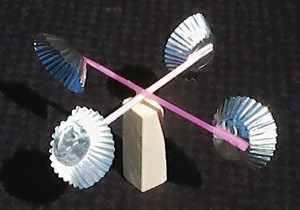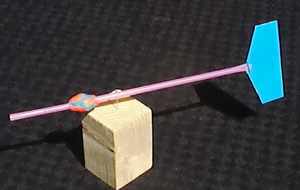|
EXPLORING MARS
Action-pak
MARTIAN WEATHER
GOALS: To understand the causes of weather on Earth.
To understand how weather patterns form on Mars, relating them to similar conditions on Earth.
To understand the differences between Earth and Mars, which give rise to its unique character.
To design an amateur weather station for a future Mars lander, which can return information visually.
OVERVIEW: The weather on Earth is a highly complex machine, still not fully understood. It receives its energy from the Sun, and the behaviour of the Sun can have profound consequences. Earth is warmer than it should be for its distance from the Sun. As well as the effects of our thicker atmosphere, this is due in large part to our oceans, which take a long time to heat up and an equally long time to cool. The oceans thus form a reservoir of heat, which they move over the whole planet, moderating climatic extremes. Mars has no oceans, a very thin toxic atmosphere, and is half as far again away from the Sun as Earth. It receives only 44% of the amount of solar heating as does the Earth, yet it still shows weather patterns similar to Earth in many respects. Mars' weather is in many respects simpler than ours, because of these differences, and so can give us an insight into how our own weather systems work.
PROCEDURE: Compare Mars and the Earth in terms of size, mass, density, gravity and distance from the Sun. With just that information, what conclusions might you draw as to what the surface conditions are like? Give reasons for your statements.
Unlike the Earth, Mars has no trace of water on its surface, and very little [0.03%] in its atmosphere; however, there are dry river valleys, lakebeds and old sea shores, showing that this wasn't always the case in the past. On Earth, the oceans stay warm, and transport the heat around the whole planet, so that Earth has an average temperature of ~25C (~77F). Water vapour in the atmosphere also acts as a "greenhouse gas", helping to keep the sun's heat in.
Mars' atmosphere is very thin, <1% of ours; this is equal to the pressure in Earth's atmosphere at a height of 32 km (20 miles). Mars is also farther away from the Sun than us, and receives only 43% as much sunlight. How do these facts fill in your picture of the surface of Mars? If you could stand on the surface of Mars safely, without a spacesuit, what do you think you would hear, taste, see and smell?
Temperatures ranges from +30C (+86F), to -110C (-166F), and Mars loses heat very quickly at night. Why do you think this might be? Are there any areas of Earth which behave in a similar way?
Although the atmosphere is so thin, there are still winds there, which can reach 160 kph (100mph), and lift the Martian dust into the atmosphere, causing enormous dust storms that can cover the whole planet. When seen from Earth, these were called "yellow clouds". What effect do you think these dust storms might have on Mars' weather systems. Mars also has "white clouds", and the Pathfinder lander took some very beautiful pictures of Martian clouds. If you can access them in a book or on the web, can you identify the type of cloud they are, by comparing them with Earth clouds?
If Mars has no oceans, how do you think clouds can form? What might they be made of?
Look up the different types of cloud formation on Earth. What does each type of cloud mean?
When it is winter at one of the poles, Mars' atmosphere gets thinner than it normally is and there is a movement of part of the atmosphere in that direction, which reverses when it is winter at the other pole. Bearing in mind the very low temperatures of Martian winters, and the fact that the atmosphere is 95% carbon dioxide, what do you think might be happening? What effects do you think this would have on the weather and the dust on the surface?
PROJECT: Make a Wind Monitoring System.

Key elements of a Weather Station - the weather vane (left) and the anemometer (right).
Using simple, waste materials build a weathervane and an anemomter (wind speed recorder).
Materials:
- 3 Drinking Straws
- Plasticine
- Sticky tape
- 2 Small Wooden Blocks
- 2 Pins
- Staples
- Card
- 4 Foil Cake Dishes
Tools
- Stapler
- Scissors
- pencil
- ruler
Assemble the instruments as shown in the pictures:

Anemometer: Staple the foil dishes to the straws. Tape the straws together and use a pin as the pivot. A block of wood is the base. Held in the wind, the cups will rotate. The instrument can be calibrated by marking one cup with paint and counting the number of times the cup rotates per minute. You can develope your own wind scale. Compare your scale with wind speeds given on the weather forecasts, or better still compare it with a local anemometer. Research wind scales - eg, Beaufort Scale.

Weather vane: Cut a tail from the card. staple this to a straw. Pin the centre as a pivot to a wooden block and add Plasticine as a counterbalance. Held in wind the vane will point to the direction the wind is coming from. Look out for local weather vanes. Compare at the designs.
Go to Previous Page
Click here to return to the Exploring Mars Lessons Index
|





